Papers by Christian Reynolds
Regional Studies, 2017
This is a repository copy of A sub-national economic complexity analysis of Australia's states an... more This is a repository copy of A sub-national economic complexity analysis of Australia's states and territories.
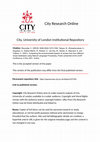
The calculation of environmental impacts from recipes remains a barrier to effective uptake of su... more The calculation of environmental impacts from recipes remains a barrier to effective uptake of sustainable diets. In our project, we use pilot digital humanities methods to explore digitised recipe texts from websites in English, Dutch and German. Using the natural language processing toolkit GATE [1], we have developed customised tools to automatically extract ingredients, quantities and units from 220,168 Indexed recipes and match them to a food environmental impact database of 4500 ingredients (using the classification system FoodEx2). This database, based on environmental data from Poore and Nemecek (2018), provided Land Use (m2/FU), GHG Emissions (kg CO2eq/FU, IPCC 2013 incl. CC feedbacks), Eutrophying Emissions (g PO43-eq/FU, CML2 Baseline), Stress-Weighted Water Use (L/FU), and Freshwater Withdrawals (L/FU) for each ingredient. This allowed the calculation of these impacts at the mean, 5% and 95% confidence level per recipe and per portion. This has enabled us to explore the ...
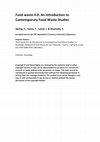
It is said that when looking back, our ancestors will recognise the legacy of the 'Anthropocene' ... more It is said that when looking back, our ancestors will recognise the legacy of the 'Anthropocene' age through the archeological marker of rubbish. Such archaeology speaks of food waste as a particular continuity of humans' habitation on planet Earth. We have consistently left traces of food, from the earliest sites of human settlement to the trash heaps of today. This rubbish consists not only of ubiquitous plastics (Liboiron, 2016) or electronic waste (Lepawsky, 2015). It also consists of food, and lots of it, evidenced by the pristine-looking 40 year-old hot dog and 25 yearold lettuce found by 'garbologist' William Rathje during his Garbage Project excavation (Rathje, 1974). Our legacy will be marked by trails of uneaten food. Global narratives of scale The amount of food the world currently wastes is overwhelming. As Trentmann (2016:622) posits, "we appear to be drowning in waste", with perfectly edible food contributing a significant portion of what we discard. Studies continue to highlight the global scale of food waste, differentiating between 'avoidable' and 'unavoidable'or edible and inedible (Nicholes et al., 2019). The preventability of vast quantities of thrown-away food has spurred ever-more concerted efforts in food waste practice and research. Well-rehearsed statistics mark out this trend, such as the
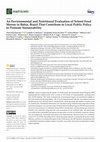
Nutrients
Aimed at improving the quality of school meals, the Sustainable School Program (SSP) implemented ... more Aimed at improving the quality of school meals, the Sustainable School Program (SSP) implemented low-carbon meals, twice a week, in 155 schools of 4 municipalities, reaching more than 32,000 students. This study evaluated the environmental impact and nutritional viability of this intervention for this population. The 15 most repeated meals from the conventional and sustainable menus were selected, and we considered the school age group and number of meals served per student/day. Nutritional information was calculated using validated food composition tables, nutritional adequacy was assessed using National School Feeding Program (PNAE) requirements, the level of processing was considered using NOVA classification, and greenhouse gas emissions (GHGE) were estimated using food life cycle assessment (LCA) validated data. We found both conventional and sustainable food menus are equivalent, in terms of nutrients, except for calcium, iron, and magnesium. Sustainable food menus were choles...
The main research question addressed is: What does sustainability mean to UK citizens when it com... more The main research question addressed is: What does sustainability mean to UK citizens when it comes to food and diet? The report addresses the following secondary questions: How does the UK academic literature define sustainability, ‘sustainable food’ and ‘sustainable diet’? How do citizens’ perceptions compare to the academic definition? What does sustainability mean to industry when it comes to food and diet? A number of sub-questions and themes were explored to answer the main research question, such as understanding and importance of sustainability and its impact on food choices, trade-offs, drivers and barriers to sustainable food choices and differences across demographic groups
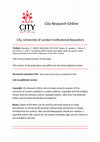
A barrier to the adoption of low carbon diets is the lack of quantification of embodied greenhous... more A barrier to the adoption of low carbon diets is the lack of quantification of embodied greenhouse gas emissions (GHGE) at the level of a recipe and/or portion, rather than the ingredient per 100g. This lack of quantification is also a barrier to the deployment of carbon labels for the out of home/hospitality sector due to there being no quick method of footprinting and carbon labelling entire menus, product lines etc. This poster/paper seeks to fill this gap, presenting a data set of GHGE (grams of Co2e) per portion, per kcal, and per gram of protein, as well a carbon score A+ to G for 70,000 “generic meals”. These generic meals are representative of the most commonly eaten meals on the planet, and are typical meals served in 90% of restaurants. This dataset has been produced through collaboration between the Centre for Food Policy, City, University of London and Edamam, a provider of nutrition data and semantic solutions for businesses in the food, health, and wellness sectors (ht...
Who am I? Christian Reynolds Senior Lecturer at the Centre for Food Policy Focus: healthy sustain... more Who am I? Christian Reynolds Senior Lecturer at the Centre for Food Policy Focus: healthy sustainable diets and food consumption (including waste) Previously: Food waste politics/history, social sciences approaches Just publish: Sustainability and cooking (16% of UK food GHGE!) 60%+ of some foods!
Food production and consumption impacts upon climate Climate impacts upon food production and con... more Food production and consumption impacts upon climate Climate impacts upon food production and consumption • The "little ice age" of 1500-1700, or "age of extremes" of 1310s-1810s, changed what Europeans (etc.) farmed, ate, cooked, modes of production, consumption etc. • Created resilient societies. (Lots of war, famine etc. !) • Led to the start of the current European (and global) dietary patterns, and food regimes. These (cool) food systems, crops, modes of production, and diets are foundational for the modern food system. Probably only ever a max 0.5°C cooling! Food Climate
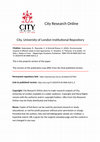
Waste to Food, 2022
All waste treatment options have environmental impacts. As waste to food is one of the many possi... more All waste treatment options have environmental impacts. As waste to food is one of the many possible ways to valorise (or treat) food waste, environmental impacts of different waste to food processes need to be compared alongside other waste treatment methods. In addition, the environmental impact of the prevention of waste needs to also be compared to waste to food impacts. This chapter introduces the method of Life Cycle Assessment (LCA) to evaluate the environmental impacts of various production and treatment options. We highlight multiple methods to conduct environmental impact assessment, including a bottom up LCA, or a hybrid IO-LCA approach. We cover the drawbacks and limits of these different LCA methods. We highlight best practice waste to food environmental assessment case studies, including the REFRESH FORKLIFT toolkit. We intend for this chapter to be a broad introduction to this topics, empowering a decision maker or researcher to understand the processes, and limits of waste to food environmental impact assessments.

Modifying packaging, portioning, and pack-size are over looked areas when reducing food products&... more Modifying packaging, portioning, and pack-size are over looked areas when reducing food products' environmental impacts. Currently, 45% of UK food purchased is wasted because it wasn't used in time – this could be addressed by modification to pack formats and portion sizes. In addition, Single-person households waste 40% more per capita than other household types, citing pack-sizing and pricing as the main reason. Furthermore, around 31% of avoidable food waste in households (1.3Mt) arise specifically because people " prepared and served too much " , again solved in part by pack formats and portion sizes. In addition there are synergies with public health goals as pack sizes and portioning are also seen as an intervention with the highest potential to improve the public health costs of obesity and related diseases such as diabetes. To test these claims this poster reviews the packaging, portioning, and pack-size food waste, and health issues around 2 products: Bread and Bacon. Methods • An online price sampling methodology was to capture the supermarket purchase price range, and packaging weights of bread and bacon food items, across 4 supermarkets chains (Tesco, Sainsbury's, Morrison's, and ASDA). • The National Diet and Nutrition Survey, and the Family Food survey were sampled to find the typical eaten portion range, and the typical quantity eaten daily per person of bread and bacon across the UK population for 2013/2014. • WRAP reports (Reducing food waste by extending product life, 2015) were used to find the minimum, average, and maximum Total Life of Bread and Bacon. Results • 32 Bacon products were sampled, ranging from 180g to 700g. The weights of 200g, 220g and 300g had Split pack product innovations. These were cheaper than their equivalent non split pack items. The median cost of smaller pack sizes were more expensive than larger, the 180g pack cost 54% more than the 300g pack (most common pack size). • 122 Bread loafs were sampled, ranging from 400g to 800g. The median cost of smaller pack sizes were more expensive than larger, the 400g loaf cost 20% more than the 800g pack (most common pack size). • The median portion of bread is 57g, with an average daily consumption of 21g per person. • The median portion of bacon is 50g, with an average daily consumption of 15g per person. • The UK Eatwell guide recommended amount of red or processed meat is 70g per week. Average weekly UK Bacon consumption is currently below this. However, many of the pack sizes are hard to separate into units divisible by 70g, but easier to divide by 50g or 100g. In addition, there were many instances of bacon portions being above 70g in NDNS data, meaning many people are eating more bacon than is healthy. • The 3.1 day Available life of bread, combined with large loaf sizes results in large amounts of waste for single person, and average households. • The 12.2 day Available life of bacon, combined with moderate pack sizes results in waste for single person households only in all packets besides 180g. In an average household, bacon waste was found in bulk packets. • No single, 2 portion, or products designed to be eaten within the Available life window were found in our sample of either food. • For Bacon the maximum single person size is: 180g, for a family: 450g. • For Bread the maximum single person size is: 65g (3 slices), for a family: 160g (9 slices).

apturing the ‘true’ price of food is important for discussions around food security and inequalit... more apturing the ‘true’ price of food is important for discussions around food security and inequality. The range of food prices can be collected at the place of purchase; or by gathering receipts from consumers. The first option is a labour intensive process that provides the price range of each food item. The second, provides only the prices paid by consumers, and may lack information on the entire price distribution as the prices collected are dependent on the consumption habits of the sampled population. Though similar, these are not interchangeable price definitions and their use could have implications on food affordability discussions. In this paper we examine the comparability between these two food price collection methods. Over the 2014-2015 time period, we used an online price sampling methodology to capture the supermarket purchase price range of 97 food items, across 4 supermarkets chains (Tesco, Sainsbury’s, Morrisons, and ASDA). We compare this range of supermarket prices to mean consumer purchase prices as sourced from the 2012 Kantar Worldpanel purchase data, and the 2014 UK Living Costs and Food Surveys (LCFS). It was found that 53 (55%) of the Kantar mean food item prices, and 57 (59%) of the LCFS mean food item prices, were within the interquartile range of our supermarket price sample. 91 (93%) of the Kantar, and 95 (98%) of the LCFS mean food item prices were within our supermarket price sample These differences can be attributed to expensive ‘luxury’ priced food items (e.g meat, cheese, exotic fruits etc.), and goods that have reduced costs for ‘basic’ or bulk purchases (e.g milk, bread, butter etc.) skewing the price paid by the consumer when compared to the range of prices available at the supermarket. This implies that certain foods may not be well represented by the average consumer purchase price.

We present the most developed application of household food waste DES to date: the new Household ... more We present the most developed application of household food waste DES to date: the new Household Simulation Model (HHSM), a DES model focusing on understanding household food waste. The HHSM provides the flexibility to model a range of food items and includes many household dynamics that can affect food waste (e.g. purchasing, storage, consumption). The HHSM simulates a range of household types to reflect the diversity of the UK population. <br>In this deposit we provide:<br>1) A version of the HHSM to be used with ARENA Simulation Software version 15.1 (.doe)2) The siman code of the HHSM.<br>The methodology and further description of the model can be found in the document USING DISCRETE EVENT SIMULATION TO EXPLORE FOOD WASTED IN THE HOME - currently under review (2020) at the Journal of Simulation.<br>For further published reading on the HHSM see:<br>https://wrap.org.uk/sites/files/wrap/Household Simulation Model Methodological Summary.pdf https://core...
This paper explores and establishes the concept of how power (energy) is used and embodied in foo... more This paper explores and establishes the concept of how power (energy) is used and embodied in food and cookery. It then examines how different types of cookery methods use different amounts of power, and thus cooking the same food using different methods can have different environmental impacts. It then investigates the history of “sustainable cookery”, performing a comprehensive review of historic cookbooks to highlight 23 key texts. These range from Frances Moore Lappe’s “Diet for a Small Planet” (1971), through to contemporary texts such as Diana Henry’s “Plenty: good, uncomplicated food for the sustainable kitchen” (2010), or the 4 books of the American Academy in Rome’s Sustainable Food Project (2011). These texts will be used to examine how concepts of sustainability have evolved over time.
This file contains an archive copy of the blog post from the "Recipes Project" https://... more This file contains an archive copy of the blog post from the "Recipes Project" https://recipes.hypotheses.org/17062<br>This blog post describes the results of a community survey which was run from October to December 2019 by the US-UK Food Digital Scholarship Network . The survey asked what (and how) food scholars are currently using analogue and digital material. The network was also interested how the community thought US and UK libraries and archives could better support food researchers through digitisation and activities.<br>Ethical permission for the survey was given by the Geography Department, University of Sheffield, on the 19/9/2019. PROJECT TITLE: Digital humanities and food research mapping APPLICATION: Reference Number 030674







Uploads
Papers by Christian Reynolds
In this paper we examine the comparability between these two food price collection methods. Over the 2014-2015 time period, we used an online price sampling methodology to capture the supermarket purchase price range of 97 food items, across 4 supermarkets chains (Tesco, Sainsbury’s, Morrisons, and ASDA). We compare this range of supermarket prices to mean consumer purchase prices as sourced from the 2012 Kantar Worldpanel purchase data, and the 2014 UK Living Costs and Food Surveys (LCFS).
It was found that 53 (55%) of the Kantar mean food item prices, and 57 (59%) of the LCFS mean food item prices, were within the interquartile range of our supermarket price sample. 91 (93%) of the Kantar, and 95 (98%) of the LCFS mean food item prices were within our supermarket price sample
These differences can be attributed to expensive ‘luxury’ priced food items (e.g meat, cheese, exotic fruits etc.), and goods that have reduced costs for ‘basic’ or bulk purchases (e.g milk, bread, butter etc.) skewing the price paid by the consumer when compared to the range of prices available at the supermarket. This implies that certain foods may not be well represented by the average consumer purchase price.